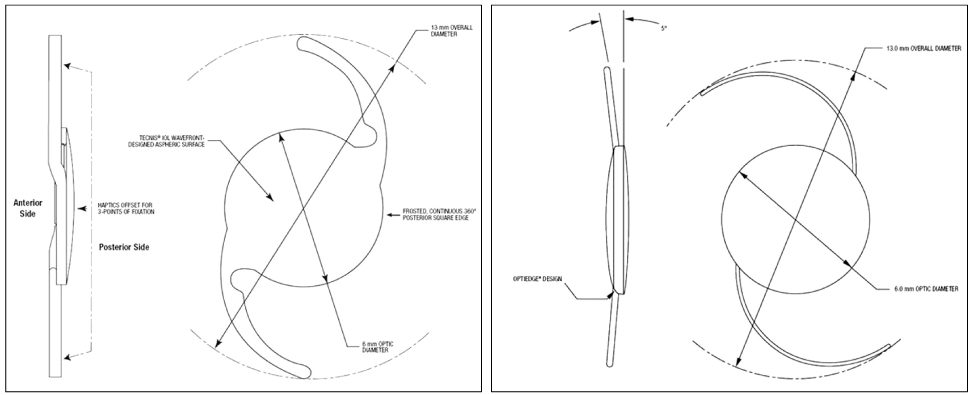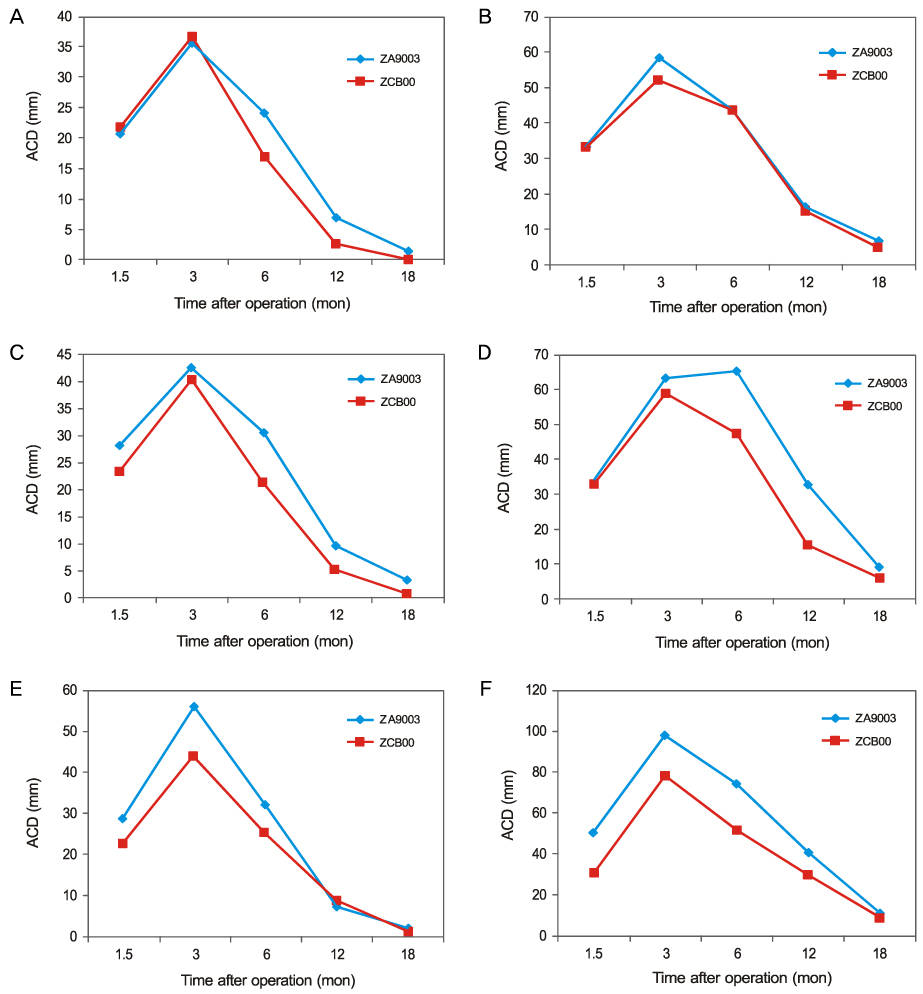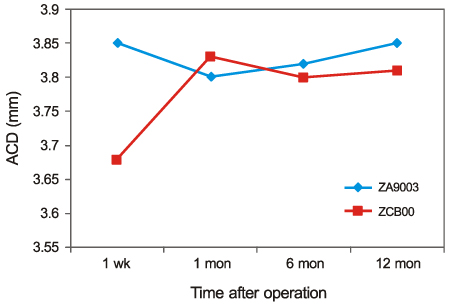J Korean Ophthalmol Soc.
2012 Oct;53(10):1451-1457.
Clinical Outcomes of Aspheric 1-Piece (Tecnis(R) ZCB00) and 3-Piece (Tecnis(R) ZA9003) Aspheric Intraocular Lens for 12 Months
- Affiliations
-
- 1Department of Ophthalmology, Asan Medical Center, University of Ulsan College of Medicine, Seoul, Korea. hwtchah@amc.seoul.kr
Abstract
- PURPOSE
To evaluate the postoperative outcome of Tecnis(R) ZCB00 1-Piece acrylic intraocular lens (IOL), the new single piece, aspheric IOL until 12 months.
METHODS
Sixty eyes undergone cataract surgery using two different IOLs; The Tecnis(R) ZCB00 1-Piece Acrylic IOL (30 eyes) and the Tecnis(R) ZA9003 3-Piece Acrylic IOL (30 eyes). Cataract surgery was performed in the same period. All complicated cases were excluded. Best corrected visual acuity (BCVA), refractive error, photopic and mesopic contrast sensitivity, total high order aberration, spherical aberration and anterior chamber depth were measured preoperatively and at 1, 6 and 12 months after surgery.
RESULTS
There were no statistically significant differences between two groups in BCVA, refractive error, total high order aberration and spherical aberration all the time after surgery. Both groups have negative ocular spherical aberration until 12 months after surgery. 1-piece and 3-piece groups had different tendency in axial movement. But there were no statistically significant differences in anterior chamber depth measured at 1 week, 1, 6 and 12 months after surgery. There was no statistically significant difference in contrast sensitivity at 1, 6 and 12 months after surgery.
CONCLUSIONS
The Tecnis(R) ZCB00 1-Piece acrylic intraocular lens (IOL) showed comparable clinical outcomes to the Tecnis(R) ZA9003 3-Piece acrylic intraocular lens (IOL) until 12 months after cataract surgery. 1-piece and 3-piece IOL group had different tendency in axial movement. However, refraction remained stable during 12 months after surgery. Mostly, both IOL groups had negative ocular spherical aberration during whole follow-up period.
MeSH Terms
Figure
Reference
-
1. Jeong JH, Kim MK, Wee WR, Lee JH. Comparison of optical performances in eyes implanted with aspheric and spherical intraocular lenses after cataract surgery. J Korean Ophthalmol Soc. 2010. 51:1445–1452.2. Kohnen T, Klaproth OK. Aspheric intraocular lenses. Ophthalmologe. 2008. 105:234–240.3. Lee JS, Yoon TJ, Ahn JH. Comparison of the clinical effects of implantation of aspheric and spherical intraocular lenses. J Korean Ophthalmol Soc. 2009. 50:1514–1519.4. Ahn H, Kim SW, Kim EK, Kim TI. Wavefront and visual function analysis after aspherical and spherical intraocular lenses implantation. J Korean Ophthalmol Soc. 2008. 49:1248–1255.5. Kim HS, Kim SW, Ha BJ, et al. Ocular aberrations and contrast sensitivity in eyes implanted with aspheric and spherical intraocular lenses. J Korean Ophthalmol Soc. 2008. 49:1256–1262.6. Peng Q, Visessook N, Apple DJ, et al. Surgical prevention of posterior capsule opacification. Part 3: Intraocular lens optic barrier effect as a second line of defense. J Cataract Refract Surg. 2000. 26:198–213.7. Behrouz MJ, Kheirkhah A, Hashemian H, Nazari R. Anterior segment parameters: comparison of 1-piece and 3-piece acrylic foldable intraocular lenses. J Cataract Refract Surg. 2010. 36:1650–1655.8. Chae JK, Jang JW, Choi TH, Lee HB. Changes in refraction and anterior chamber depth according to the type of the intraocular lenses. J Korean Ophthalmol Soc. 2006. 47:1935–1942.9. Hayashi K, Hayashi H. Comparison of the stability of 1-piece and 3-piece acrylic intraocular lenses in the lens capsule. J Cataract Refract Surg. 2005. 31:337–342.10. Heo H, Kim HG, Yoon KC, Park YG. Comparison of long-term results between one-piece and three-piece acrylate intraocular lens. J Korean Ophthalmol Soc. 2008. 49:245–252.11. Son SW, Seo JW, Shin SJ, Chung SK. Comparison of the stability between three-piece and single-piece aspheric intraocular lenses. J Korean Ophthalmol Soc. 2010. 51:1584–1589.12. Lim TH, Lee JR, Choi KY, Cho BJ. Anterior and posterior corneal spherical aberration measured with pentacam in the Korean. J Korean Ophthalmol Soc. 2010. 51:816–821.13. Shimozono M, Uemura A, Hirami Y, et al. Corneal spherical aberration of eyes with cataract in a Japanese population. J Refract Surg. 2010. 26:457–459.14. Beiko GH, Haigis W, Steinmueller A. Distribution of corneal spherical aberration in a comprehensive ophthalmology practice and whether keratometry can predict aberration values. J Cataract Refract Surg. 2007. 33:848–858.15. Chantra S, Pachimkul P, Naripthaphan P. Wavefront and ocular spherical aberration after implantation of different types of aspheric intraocular lenses based on corneal spherical aberration. J Med Assoc Thai. 2011. 94:Suppl 2. S71–S75.16. Packer M, Fine IH, Hoffman RS. Aspheric intraocular lens selection based on corneal wavefront. J Refract Surg. 2009. 25:12–20.17. Applegate RA, Marsack JD, Ramos R, Sarver EJ. Interaction between aberrations to improve or reduce visual performance. J Cataract Refract Surg. 2003. 29:1487–1495.18. Wirtitsch MG, Findl O, Menapace R, et al. Effect of haptic design on change in axial lens position after cataract surgery. J Cataract Refract Surg. 2004. 30:45–51.
- Full Text Links
- Actions
-
Cited
- CITED
-
- Close
- Share
- Similar articles
-
- Comparison of Anterior Chamber Parameter and Refractive Change between Three-Piece and Single-Piece Aspheric Intraocular Lenses
- Comparisons of Clinical Results after Implantation of Three Aspheric Intraocular Lenses
- Comparisons of Clinical Results after Implantation of Three Aspheric Intraocular Lenses
- Comparing Clinical Results after Intraocular Lens Implantation Surgery Using Three Other Aspheric Lenses
- Comparative Study of Clinical Outcomes between 2 Types of 3-Piece Aspheric Intraocular Lenses




